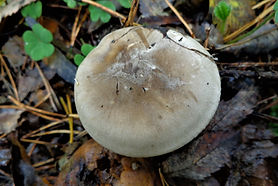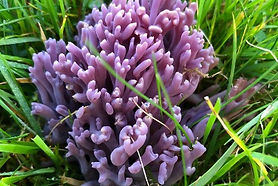.png)
Find-a-Fungus -
List of 20 fungi for you to find
The Find-a-Fungus project will be live on iNaturalist from 29th September to 10th October 2025. You can join the project before it opens, but don’t forget to return, to record the fungi you find! You'll need an iNaturalist account, and search for the project name "UK Fungus Day - Find-a-Fungus". Read more about how to take part.

Amethyst Deceiver – Laccaria amethystina
This small mushroom has a striking purple colour, although it fades with age or in dry weather. It often grows in leaf litter in broadleaf and conifer woodlands, especially in late summer and autumn. Look for its thin, fibrous stem and widely spaced gills. Despite its vivid colour, it can be well-camouflaged against forest floor debris.
Image by Ailsa Carlaw

Beefsteak Fungus – Fistulina hepatica
This large, tongue-shaped fungus has a reddish, meaty appearance that resembles raw liver or beefsteak. Found mainly on old oak and sweet chestnut trees, it often oozes a blood-like fluid when cut. It grows directly from the trunk or base of trees, usually in late summer and autumn. Its surface is moist and bumpy, and the underside has tiny pores rather than gills.
Image by Mark Ramsdale

Birch Polypore – Fomitopsis betulina
This bracket fungus is typically found growing on dead or dying birch trees. It forms hoof-shaped, pale grey to white caps with a smooth surface and no gills underneath—just tiny pores. The fruiting bodies can persist all year round, making it easier to spot in any season. Look for it in birch woodland or areas where birch trees have recently fallen.
Image by Norbert Nagel , Wikimedia Commons, License: CC BY-SA 3.0

Candle Snuff – Xylaria hypoxylon
Candle snuff appears like tiny black twigs with white, powdery tips—hence its nickname “stag’s horn.” It grows on decaying wood, especially old tree stumps and branches in damp, shaded woodland. The white tips are the spore-producing part, and they glow faintly under UV light. It’s often seen in late autumn through winter.
Image by Mark Pike

Clouded Agaric – Clitocybe nebularis
This large, pale grey mushroom has a cloud-like appearance and a strong, somewhat unpleasant smell. It grows in dense groups in deciduous and coniferous woodland, often forming fairy rings. The cap is broad and funnel-shaped as it matures, and the gills are white and crowded. Found mainly in autumn, it should be handled with care, as it may cause stomach upset in some people.
Image by Екатерина Войнова, CC BY 4.0, via Wikimedia Commons

Collared Earthstar – Geastrum triplex
This unusual fungus looks like a puffball sitting in a star-shaped base. When mature, the outer layer splits into segments that fold back to reveal a central spore sac. It grows on the ground in leaf litter in broadleaf woodland, especially beech woods. Best spotted in autumn, it can resemble a dry, earth-toned ornament among fallen leaves.
Image by Mark Ramsdale

Fly Agaric – Amanita muscaria
Easily one of the most iconic fungi, this bright red mushroom with white spots is often seen in fairy tale illustrations. It typically grows beneath birch, pine, or spruce trees, often in autumn. The cap starts domed and flattens with age, and the white spots are remnants of a protective covering. It's poisonous, so admire but don’t touch or pick.
Image by Gary Cox

Hoof Fungus – Fomes fomentarius
Resembling a horse’s hoof, this hard, grey bracket fungus grows mainly on birch, beech, and other broadleaf trees. Its tough texture and concentric ridges help distinguish it from other bracket fungi. Found year-round, especially on standing deadwood, it can persist for years. It has historical significance as a firestarter—hence its other name, tinder fungus.
Image by Cameron Diekonigin

King Alfred’s Cakes – Daldinia concentrica
These black, rounded lumps resemble burned coal or cakes left in the fire—hence the name. Found on dead or dying ash and beech trees, they are hard and woody to the touch. If broken open, you’ll see concentric rings inside. They are most commonly found year-round but especially easy to spot in winter when trees have lost their leaves.
Image by bogsuckers, CC BY 4.0 via Wikimedia Commons

Ochre Brittlegill – Russula ochroleuca
This medium-sized mushroom has a dull yellow, ochre cap and white, brittle gills. It’s common in both coniferous and deciduous woodlands, often growing alone or scattered. The cap surface is dry and often slightly sticky when wet, while the stem snaps cleanly like chalk.
Image by Mark Ramsdale

Orange Ping-Pong Bat – Favolaschia claudopus
This small, vibrant orange fungus has a fan or disc-shaped cap with large, clearly visible pores on the underside. It typically grows on rotting wood in warm, damp environments. The cap looks almost like a miniature table tennis bat. It is not a native species to the UK but is spreading rapidly and is a good one to record if found.
Image by Awhesian, CC0, via Wikimedia Commons

Parasol Mushroom – Macrolepiota procera
This tall and elegant mushroom has a scaly brown cap that can reach dinner plate size when mature. It grows in grassy clearings, woodland edges, and meadows, often from late summer into autumn. The stem has a distinctive snakeskin pattern and a movable ring. Its large size and graceful stature make it easy to spot.
Image by Richard Bowman

Shaggy Inkcap – Coprinus comatus
This tall, cylindrical mushroom is white with shaggy scales, resembling a lawyer’s wig. It appears in grassy areas like lawns, verges, and parkland, often in groups. As it ages, the cap turns black and dissolves into an inky liquid. It's most visible in late summer and autumn, especially after rain.
Image by Kieren Cook

Snowy Waxcap – Cuphophyllus virgineus
This delicate white mushroom grows in unimproved grasslands, often forming small groups in short, mossy turf. It has a smooth, slightly sticky cap and widely spaced white gills. Most often found in late summer and autumn, it’s a good indicator of healthy, undisturbed grassland. Watch out for it in churchyards, meadows, and old lawns.
Image by Andreas Kunze, CC BY-SA 3.0 via Wikimedia Commons

Sulphur Tuft – Hypholoma fasciculare
These bright yellow mushrooms grow in dense clusters on dead wood, especially stumps and logs. The caps are smooth and often have a greenish or orange centre. Gills are greenish-yellow when young, turning darker with age.
Image by Gary Cox

Tar Spot – Rhytisma acerinum
This fungus appears as black, tar-like spots on leaves of sycamore and other maple trees. It’s most visible in late summer and autumn when the leaves are still on the trees. It doesn’t harm the tree significantly but is very distinctive. Look for it on fallen leaves as well for easier collection and observation.
Image by Rhododendrites, CC BY-SA 4.0, via Wikimedia Commons

Violet Coral – Clavaria zollingeri
This striking fungus looks like delicate coral, with branches coloured in vibrant lilac to purple hues. Found in unimproved grasslands, it prefers short, mossy turf and sometimes appears on woodland edges. It's generally considered to be rare. Be sure to photograph it carefully for recording due to its conservation importance and avoid picking.
Image by Cameron Diekonigin

Wood Ear – Auricularia auricula-judae
This jelly-like, brown fungus grows on elder and other broadleaf trees, often resembling a human ear. It’s soft and rubbery when fresh, drying out and rehydrating with the weather. Found year-round, especially in damp conditions, it grows in clusters. Look closely at elder branches, especially in shaded woodland.
Image by Christine Barnes

Yellow Brain Fungus – Tremella mesenterica
This bright yellow, jelly-like fungus resembles a scrambled egg or brain. It grows on dead wood, often where crust fungi are also present, as it parasitises them. Most noticeable in damp, wet weather, especially in winter. Its vivid colour makes it easy to spot on fallen branches and logs.
Image by Amelie Wiseman

Yellow Staghorn – Calocera viscosa
This small, bright yellow fungus has antler-like branches and a jelly-like texture. It’s commonly found on decaying conifer wood, including stumps and buried roots. Most visible in autumn, but can appear year-round in damp conditions. Despite its striking appearance, it’s easy to miss among moss and needles, so look carefully!
Image by Gemma Bullen